Hunder is one of the largest, most ancient, and historically significant villages in the Nubra Valley, as indicated by its original name, sngon-dar, which means earliest developed (village). It is said that the Nubra kings lived in the palace (Photang Dechen Tsemo) in Hunder, before King Tashi Namgyal annexed Nubra to the Ladakhi kingdom. Later on, King Tsewang Namgyal appointed Kaga Lobzang Stanzin from Hunder Zimskhang as an able minister (lonpo) of the Namgyal dynasty. The latest development in history was that Princess Norzin Angmo of Hunder Zimskhang married into the Yabgo family in Khapulu in Baltistan. A folk song composed by Norzin Angmo about the event is still widely sung in Ladakh. It is also said that the mother of King Singay Namgyal, Gyal Khatun, died in Hunder village.
In order to conserve the legacy and the heritage places in Hunder, Shri Skalzang Dorjey and family members (Karma Inn) have sponsored an establishment of a heritage park and the installation of a Tara statue, which was brought from Nepal and installed in the precinct of sacred Skalzang Mani in memory of late Mrs. Tsetan Angmo. The Goba (village chief) and the Hunder community supported the initiative. The consecration ceremony was held on September 13, 2024.
Dr. Sonam Wangchok delivered his keynote speech on the occasion of the consecration ceremony of the newly installed statue of White Tara and the establishment of heritage park in the precinct of Skalzang Mani in Hunder, Nubra. In his speech he underlined that the actual year of construction of the historical Skalzang Mani is not known, but inscriptions on the stones indicate that it represented several periods from the 15th to the 17th century. “Four Nubra local rulers— Bha-ga-ram-mir, Nima Grags, Namgyal Tashi and Tsewang Stanba —as well as a number of other names that sponsored the Mantras carved on the Skalzang Mani and the other surrounding Mani walls are mentioned in the stone inscriptions placed on the Mani walls”, said Dr. Wangchok.
According to Dr. Wangchok, the Buddhists from Tibet used to send offerings to Skalzang Mani, and they asked pilgrims and traders visiting Nubra to circumambulate and pray at Skalzang Mani on their behalf. The belief is that one may accumulate merits and fulfil prayers by circumambulating the Mani with a pure and spiritual intent. The names of the thousand Buddhas engraved on stones and placed on the Mani wall gave rise to the name Skalzang (aeon of great fortune). It is one of the most sacred monuments in Ladakh.
Nubra is home to significant rock-cut statues of Bodhisattvas, petroglyph sites, monasteries, temples, forts, stupas, mediation caves, Mani walls, and sacred landscapes. Hunder is a significant historical site where the Nubra Kings lived and ruled prior to King Tashi Namgyal bringing the region into the Leh Kingdom. Considering all these, Dr. Wangchok urged the people of Nubra to feel proud and blessed of their rich cultural heritage. In addition, he highlighted about how many heritage sites had already lost over time and urged communities to preserve the ones that have survived for future generations.
Dr. Wangchok appreciated Shri Skalzang Dorjay and his family members and the Hunder community for initiating the heritage park with the aims of preserving and maintaining the historical and sacred Skalzang Mani by keeping its originality intact. He also urged people to understand the historical, archaeological, religious, social and cultural values before restoring any heritage site. He discouraged using modern materials like cement and steel to restore ancient monuments without knowing the heritage restoration norms. Given the rich cultural legacy, Dr. Wangchok recommended publishing a book on Hunder village for the benefit of both local readers and tourists.
The monks from Deskit, Samstanling, and Yarma monasteries conducted the consecration ritual earlier. H.E. Drukpa Thuksey Rinpoche blessed the consecration ceremony. In his teaching, the Rinpoche highlighted the value of living in harmony, peace and unity for spiritual as well as worldly growth. While citing Dr. Wangchok, Rinpoche urged villagers, including public representatives, to take responsibility for the preservation and maintenance of their ancestral monuments.
“Many new religious monuments are being built in Ladakh, which I think isn’t always necessary—restoring and preserving the existing monuments built by our ancestors are more meritorious”, said Rinpoche. Rinpoche advised the devotees not to build religious monuments for competition and show off; instead respect the old monuments and maintain them well with pure heart and intention. He urged everyone to recognize the values of cultural heritage and work for their preservation. Rinpoche also advised the parents to provide the best education opportunities for their children. The consecration ceremony was followed by a vibrant cultural programme from the Hunder village communities and nearby villages.
Later in the day, Dr. Sonam Wangchok led a heritage tour for students from the Government Higher Secondary School Diskit, Nubra to several heritage sites in Hunder, including Dechen Tsemo, Skalzang Mani, Lhakhang Marpo and Lhakhang Karpo. He encouraged the students to take interest in their ancestral heritage and learn about them. Dr. Wangchok went into great detail regarding the norms and guidelines for maintaining and restoring historical sites as he answered a number of questions asked by the students. In addition, he advised the students to develop writing habits by learning about their cultural and natural heritage from their parents and grandparents, and contribute articles to local magazines like Stawa and Heritage Himalaya.
Upon his return to Leh, Dr. Wangchok shared some photos from the day on X with the caption, “I strongly believe that the only way to safeguard our cultural heritage is to educate the local communities about the different values of their cultural and natural heritage”.
Photo & Text: Ms Sonam Dechen



